Future-proofing L&D: Developing the Right Skills
April 19th, 2022
In December of 2021, ByteDance, which owns the better-known TikTok, dissolved its learning & development function. According to CNBC, the entire department was let go over the holiday break in a virtual meeting.
Their reason for this drastic move? ByteDance felt that “many learning events, such as online talks of mediocre quality…that could easily be found on the internet didn’t make good use of their employees’ time.” In an internal memo, ByteDance also mentioned that initiatives were more feel-good activities with limited and questionable value.
In short, L&D wasn’t cutting it.
L&D’s Oh Sh!t Moment
The ByteDance story—and other stories we've heard—indicate that L&D functions may be having an "Oh, sh!t!" moment. L&D functions are facing bigger, more complicated challenges than they have before. These challenges are causing L&D functions—and senior leadership—to reevaluate what they do, how they do it, and the skills they need to do it well.
Yet this moment comes at a time when L&D functions have never been more visible. The past 2 years have created renewed awareness of the importance of employee development. Indeed, L&D functions are being called upon to solve some big problems.
Many senior leaders are looking to L&D functions to guide skills, skills data, upskilling, reskilling, and mobility, in an effort to meet the needs of their ever-changing environments. Our data indicate that L&D is being involved in larger strategic discussions and workforce planning in about 50% of high-performing organizations. A percentage that high would have been unheard of a decade ago.
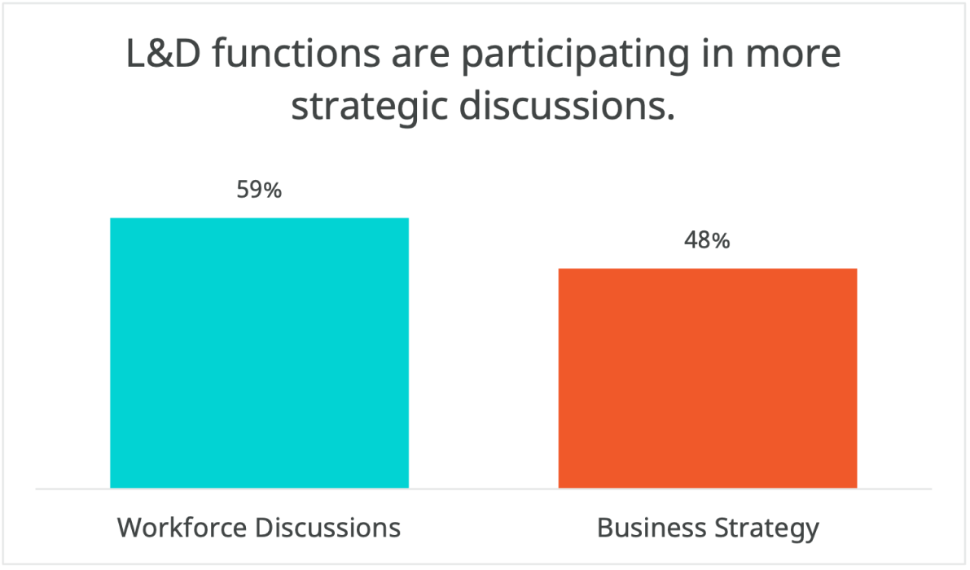
Additionally, according to Glint's 2021 Employee Well-Being Report, “Opportunities to learn and grow” is the most important driver for a great work culture, a stewardship owned by the L&D function. Employees expect more than page-turner courses or day-long events. And if we connect the dots, opportunities to learn and grow affect culture, productivity, engagement, and retention.
The problems L&D is tackling—upskilling, agile workforces, mobility, work culture—aren’t small. They’re big and important and relevant, which is both a blessing and a curse. L&D has been seeking a “seat at the table” for years. They finally, undeniably, have one. The question now is, do they have the skills they need to do something at that table?
Learning and Development Skills
We want to start by acknowledging that some good work has been done to identify skills L&D pros need. Of note are LPI, ATD, and Training Industry, all of which have capability models outlining L&D skills.
Our intent with this research was not to create another capability model. Instead, we are interested in the skills that L&D pros in high-performing organizations think they will need to focus on developing to meet near-future needs.
All the Skills
To avoid bias (and to make our lives harder), we asked 300 L&D pros the following open-ended question:
What are the top 3 skills you feel L&D functions will need for the future?
We coded their answers, combining those that were similar, and grouped them into larger skills groups.
In all, L&D pros identified 39 skills. These skills were then categorized into 7 skill groups. The graphic below shows the relational focus of these skills and groups. The larger the bubble, the more L&D pros mentioned the skill. The percentages represent the percentage of the total number of skills mentioned that fall into each category.
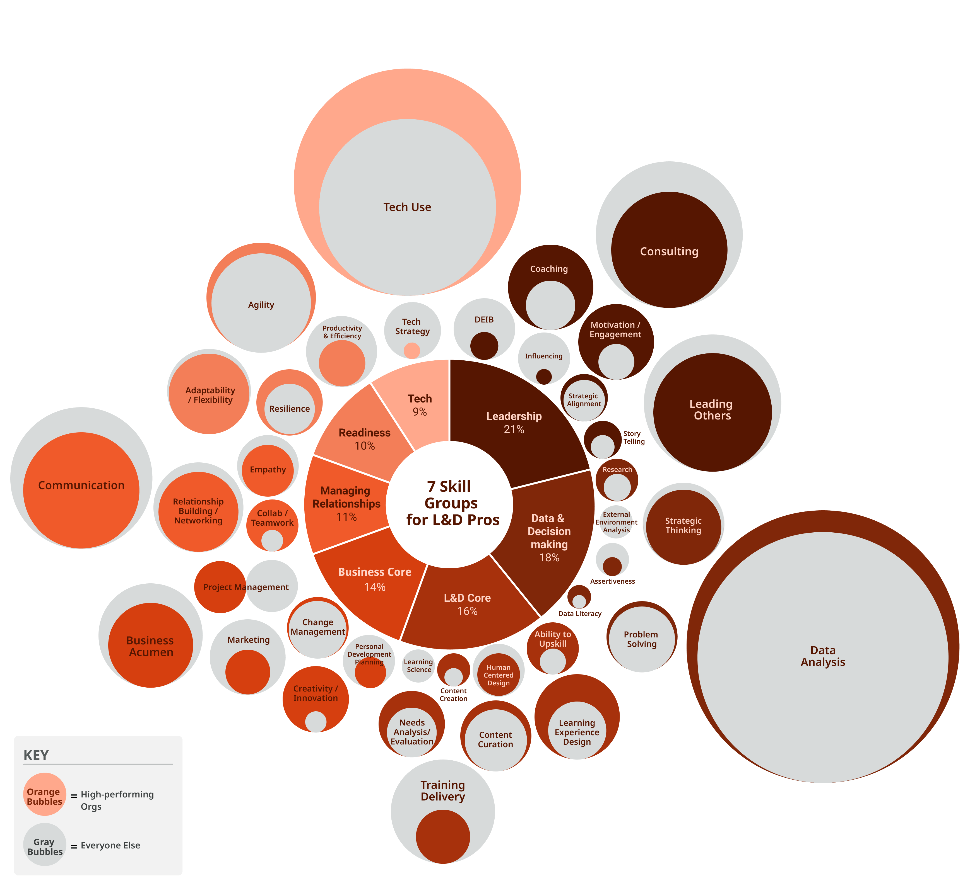
Figure 2: L&D Skills for the Future n=641. Colored bubbles = high-performing orgs; Gray bubbles = Everyone else. | RedThread Research, 2022
Click graphic to enlarge, or see our infographic for this study.
The skills identified by L&D pros were varied and nuanced. They give some insight into the kinds of challenges L&D pros and functions may be facing.
In fact, in looking at the names of the larger skills groups, we see many indications that L&D’s influence is expanding, as its responsibility:
- Leadership: skills to lead inside and outside the L&D function
- Data & Decision-making: skills to use data for making better decisions
- L&D Core: skills to build the capabilities of the workforce
- Business Core: skills to understand and align with business strategy
- Managing Relationships: skills to build and maintain relationships, internal and external to the L&D function
- Readiness: skills to help individuals and functions readily adapt to changing environments
- Tech: skills to leverage tech to upskill the workforce
This data—the skills identified by L&D pros—tells us that L&D pros need to be more than just instructional designers. They need to know much more than just adult learning theory. In this day and age, and particularly at this very strange moment in history, they need to be entrenched in the organization.
At the same time, we know that focusing on building all the skills will lead to focusing on none of them. Understanding the 39 skills L&D pros think they need is only the first step.
Understanding the ones they actually need is the next.
Skills in High-performing Organizations
Determining which skills L&D people need is an inexact art. The existing literature bases skills recommendations on expert opinion, asking L&D pros and thought leaders what challenges – and skills – L&D professionals will need next.
We took a slightly different tack. Instead of asking experts, we looked at the data L&D pros provided about the skills they thought they needed for the future. We then asked them how their organizations were performing, using these 4 measures:
- Met or exceeded its business goals for the last three years
- Responds quickly to marketplace changes
- Innovates faster than its competitors do
- Customers are more satisfied than its competitors’ customers
We then combined these 4 measures into one score and assigned that score to each L&D pro that gave us data on skills. Finally, we identified those L&D pros with scores in the top 25% to determine which were associated with high-performing organizations.
Finally, we compared the skills that L&D pros in high-performing organizations were focusing on with the ones L&D pros in other organizations named. The results, shown in Figure 3, revealed some interesting differences.
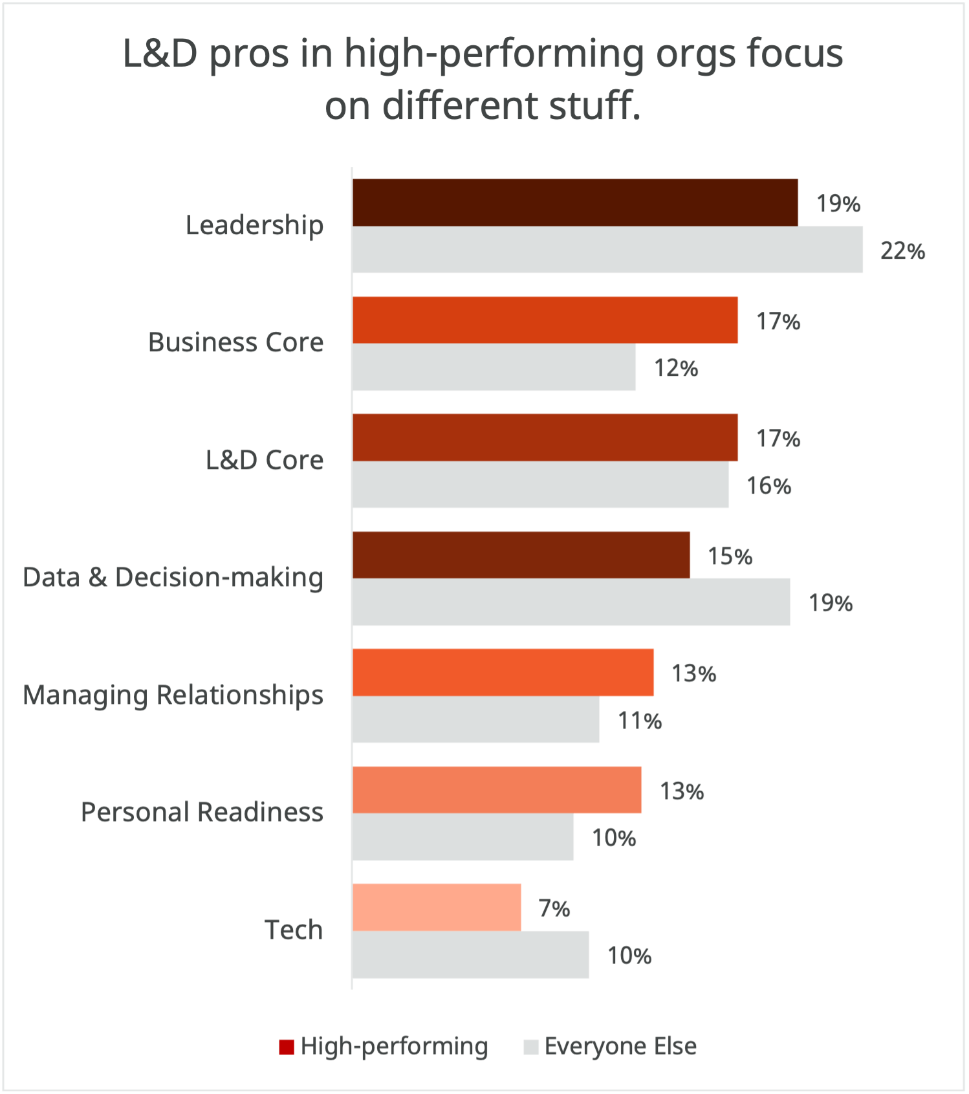
Figure 3: Focus on Skills, L&D Pros in High-performing Organizations vs. L&D pros in other organizations n=641|RedThread Research, 2022
The results got even more interesting when we combined our observations from this data with the insights we gathered from interviews and our roundtable.
Four differences stood out to us. L&D pros in high-performing organizations likely:
Are already focusing on leadership skills
We know that L&D pros in high-performing organizations participate in workforce and strategy discussions significantly more than their counterparts in other organizations.
So while it may look like L&D pros in other organizations are more focused on Leadership skills than those in high-performing organizations, it's likely because they perceive those skills as a need. L&D pros in high-performing organizations have likely already acquired them.
Have already built data into their decision-making process
Anecdotally, higher-performing organizations are more attuned to Data and do more information-gathering, and it is more ingrained in the way they currently operate. Other L&D pros may not have developed these competencies or the systems to support them in their work, resulting in a higher recognition of the need to meet future (or current) needs.
See connecting their work to the business strategy as key
L&D pros in high-performing organizations focus significantly more on Business Core skills. Both the quantitative data and the data collected from our interviews and roundtables indicate that L&D pros in high-performing organizations tend to draw more explicit connections between what they do and the goals and strategy of the organization. They also tend to have a deeper understanding of the business goals, and they tend to make decisions based on those goals.
Focus on relationships more than their counterparts do
Finally, as we'll see throughout this report, L&D pros in high-performing organizations tend to focus more on relationships.
High-performing organizations tend to have L&D pros who understand their place in the larger ecosystem and value their relationships with other functions.
These 4 broad differences can give us high-level insight into where L&D pros may want to focus. However, the devil, as they say, is often in the details.
We also saw differences among the 39 individual skills between L&D pros in high-performing organizations and their counterparts in other organizations.
The Skills Groups
In the following sections, we’ll provide more information about each of the 7 skills groups, including the individual skills within each. Our goal is to explore why each group and their respective skills may be important at this point in history.
We’re also interested in the blind spots—the places where L&D functions may be over- or under-emphasizing certain skills. To determine what those blind spots may be, we compare the skills that L&D pros are focusing on in high-performing organizations with other L&D pros may be focusing on.
Leadership
L&D pros view their own leadership skills as the most important group of skills for the future. Twenty-one percent of all skills mentioned fell within this category.
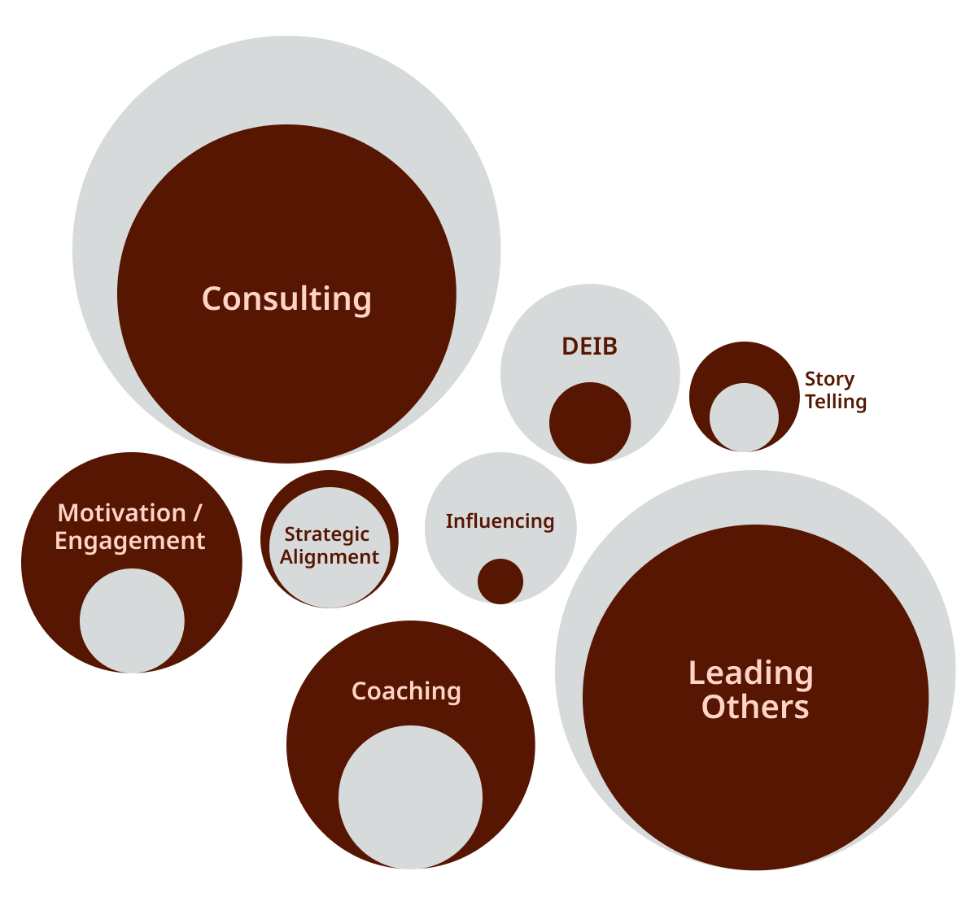
Figure 4: Leadership skills groups, n=136| RedThread Research, 2022
That 21%, validated by our interviews, are indicators of the breadth of leadership responsibilities L&D pros currently have. Kirsten Jackson, a Director of Leadership Development, told us:
We’ve really done a lot of work in the last couple of years to make sure L&D has a seat at every table—tables at the business function level to understand development needs, but also tables at the enterprise level to understand leadership expectations, goals, and how L&D can support them.
But it isn’t just these significant initiatives that L&D pros find themselves leading. In our research, we found that a lot of L&D functions are becoming much more strategic and intentional about employee development. They offer more learning methods and integrate more development opportunities into the workplace than in the past.
These changes from reactive to proactive, from just-in-case to just-in-time, and from learn-in-a-classroom to learn everywhere, require L&D functions to change the hearts and minds of business leaders and employees alike. Leadership skills like consulting, coaching, and motivation and engagement ensure that L&D professionals will be able to make these adjustments.
Leadership: Blind Spots
These findings don’t constitute hard and fast recommendations. Each L&D function should consider all of the variables – internal and external, that may affect the skills they need. That But we did identify some areas that may be getting either too much focus or not enough from the L&D professional population as a whole.
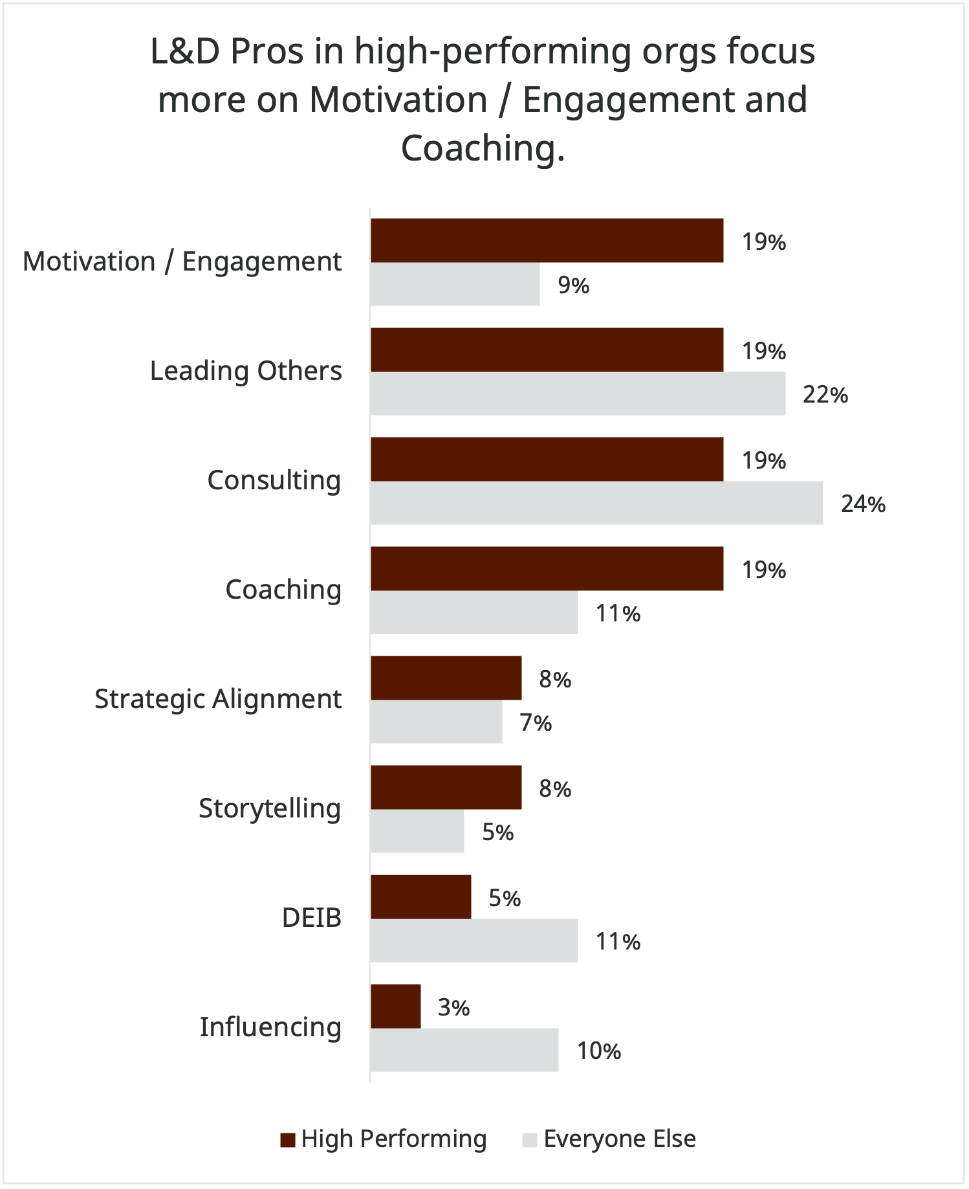
Figure 5: Leadership skills focus, L&D pros in high-performing orgs vs. L&D pros in other orgs, n=136 | RedThread Research, 2022
Focus more on Coaching, Motivation & Engagement, and DEIB
L&D pros in high-performing organizations focus almost twice as much on Coaching and Motivation & Engagement as their counterparts in other organizations.
We have observed that organizations, particularly those adopting hybrid and remote practices, are continuing to look for ways to connect and engage with employees. A stronger focus on Coaching and Motivation & Engagement can help organizations build those connections into their development practices.
Gina Montefusco, Associate Director of L&D, at United Healthcare Group, sees Coaching as a crucial skill for internal L&D leadership as well as external consulting:
Coaching is super important. You can use it to understand your business better and be more comfortable asking questions. I do think that my coaching experience has made me a better consultant overall, because now I ask questions differently.
In our 2022 yearly trends report, we mention that the human is becoming more critical. The fact that L&D pros in high-performing organizations are focusing on skills that further that mission is not lost on us.
We would also be remiss if we didn’t mention the abysmal showing for DEIB skills. While we are happy that this skill showed up at all, the percentage of L&D pros that mentioned it is pretty low. And it's even lower among L&D pros in high-performing organizations.
LinkedIn Learning’s 2022 Workplace Learning Report says that 55% of L&D functions own or share responsibility for DEIB initiatives. L&D pros should be building these skills and looking for opportunities to align their work with DEIB initiatives.
Focus on a broader set of Leadership skills
L&D pros in high-performing organizations tend to focus more evenly across key leadership skills while L&D pros in other organizations tend to focus quite heavily on just some of them.
This uneven focus may mean that L&D pros are putting too much focus on some while ignoring others. For example, L&D pros in other organizations focus more on Consulting (6 percentage points more) and Influencing (7 percentage points more) than those in high-performing organizations.
This focus on specific skills may be key to being effective in their particular organizations, but L&D pros should at least consider how they’re spending their development time and money, and what those skills can get them.
Data & Decision-making
Within Data & Decision-making, the top skill mentioned by L&D pros was Data Analysis. In general, we think that a focus on data skills is good, and it has been missing from most L&D functions for years.
We grouped Data Analysis with other skills used to make better decisions, as Data Analysis is a tool rather than an end unto itself. To be useful, Data Analysis must necessarily be tied to questions, which are ultimately tied to decisions. Other skills in this group are highlighted in Figure 6 below.
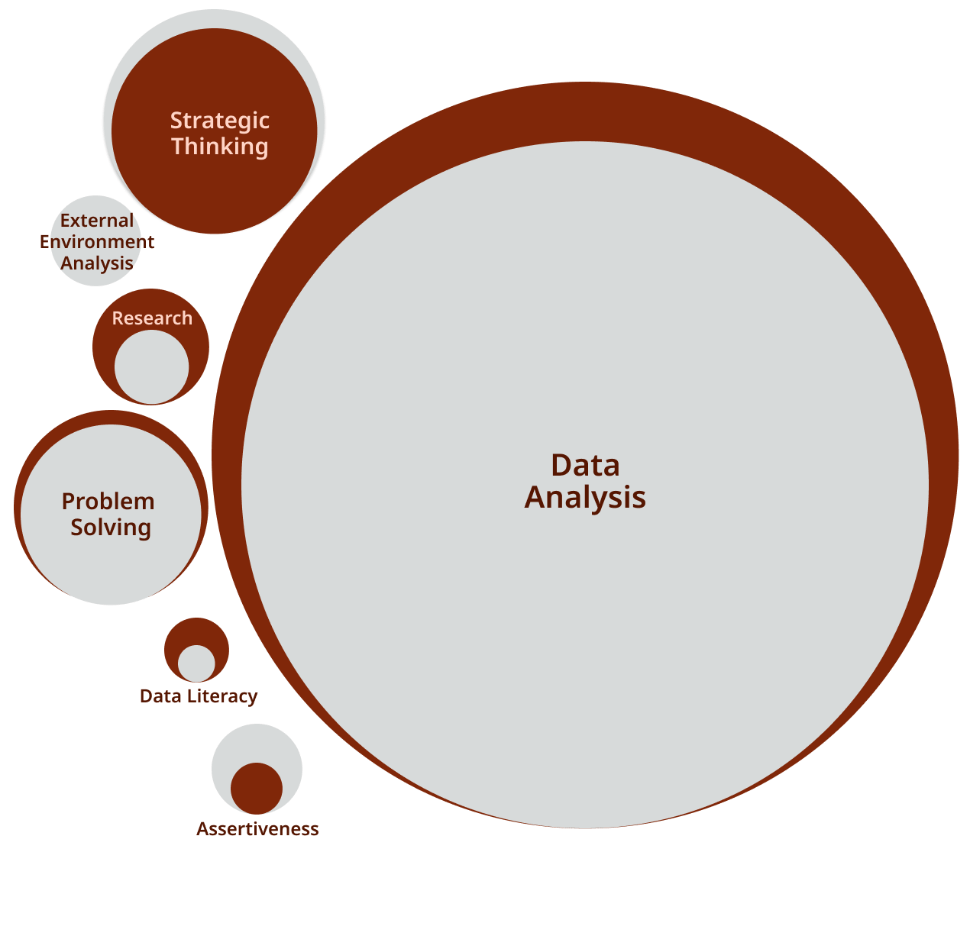
Figure 6: Data & Decision-making skills group – % of focus on each skill, n=113 | RedThread Research, 2022
As L&D pros take active roles in bigger, more strategic conversations, the need for skill in Data Analysis grows. One L&D leader mentioned that data was a language that businesses speak. Data Analysis is crucial for L&D pros as they try to identify the skills organizations and individuals need and then identify experiences that will help them grow those skills.
Many leaders mentioned that they’re looking more deeply at LMS, LXP, and other learning data to understand what their users need. Some have also started to analyze data outside of L&D. Another L&D leader, for example, looks at engagement data:
We look at data from many sources. So, for example, we look at employee engagement scores—questions like, “Do you feel supported by your manager?” This data helps us understand what our leaders will need in the future.
It’s great that L&D is focused on data. Where it gets tricky is how “data” is defined and what other sources L&D pros should be considering, which brings us to a blind spot for Data & Decision-making.
Data & Decision-making: Blind Spots
While L&D pros have started to focus on leveraging data for decision-making, they may be failing to develop other skills that could help them make sounder decisions. And by the way, this is true for all L&D pros. In this case, there was no significant difference for those in high-performing organizations.
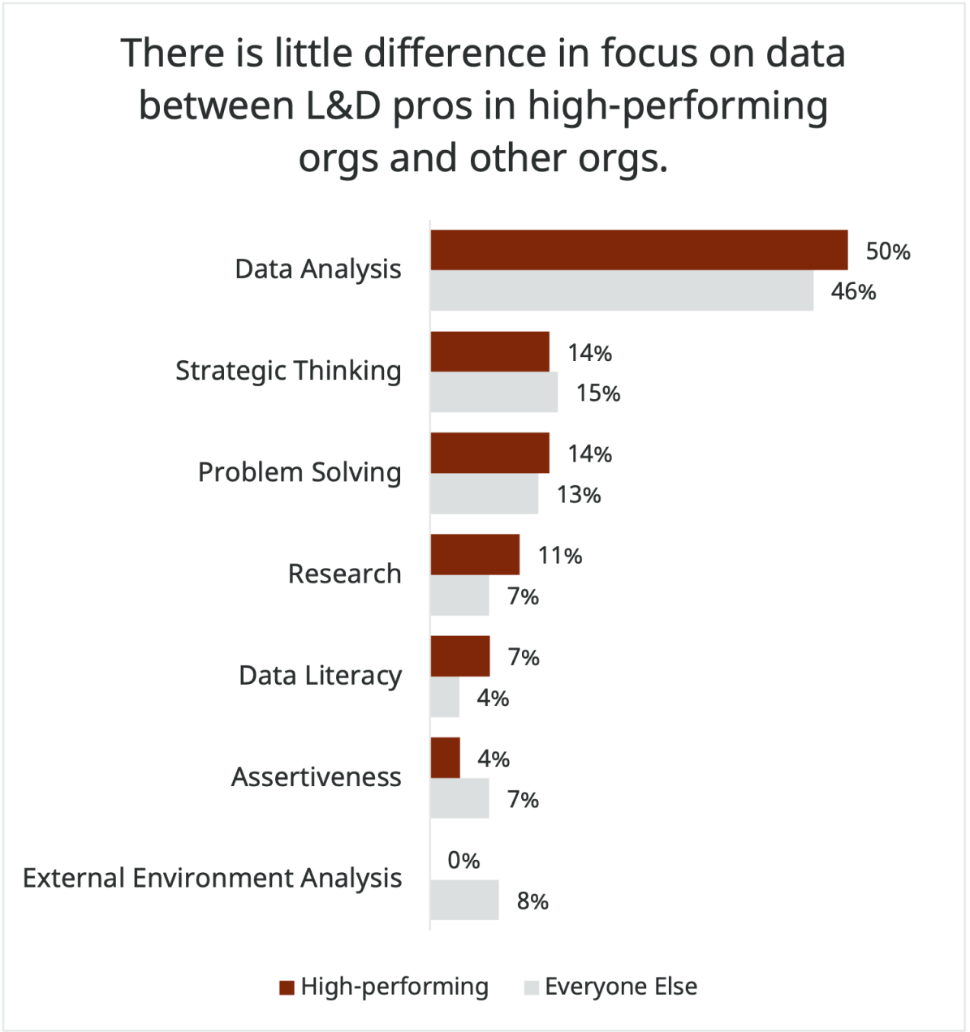
Figure 7: Data & Decision-making skills focus, L&D pros in high-performing orgs vs. L&D pros in other orgs, n=113 | RedThread Research, 2022
Focus more on different data-gathering skills
Data-gathering skills include External Environment Analysis, Data Literacy, and Research. These activities may not always result in hard numbers, but many of the insights they yield can be key to better decisions. Not all data is quantifiable. Trust us. We're researchers.
Focus more on decision-making skills
Problem-solving and Strategic Thinking fall within this subcategory. Frankly, we’re a little surprised we didn’t hear more about them. As L&D pros exercise these skills, they’ll likely see more possibilities and solutions.
So, to sum up: L&D pros recognize the need for better decision-making. And they recognize that Data Analysis skills are a big part of that. But they shouldn’t develop these skills at the expense of other underdeveloped skills.
L&D Core
Not surprisingly, L&D Core is important to L&D pros. Several pros pointed out the importance of these skills to their job and, if they were a leader, their employees’ jobs.
And rightly so: L&D pros bring an essential and unique skill set—one that no other group has—to help organizations solve the development challenges they face.
Learning Experience Design and Training Delivery top the list of skills L&D pros feel they need in the L&D core skills group.
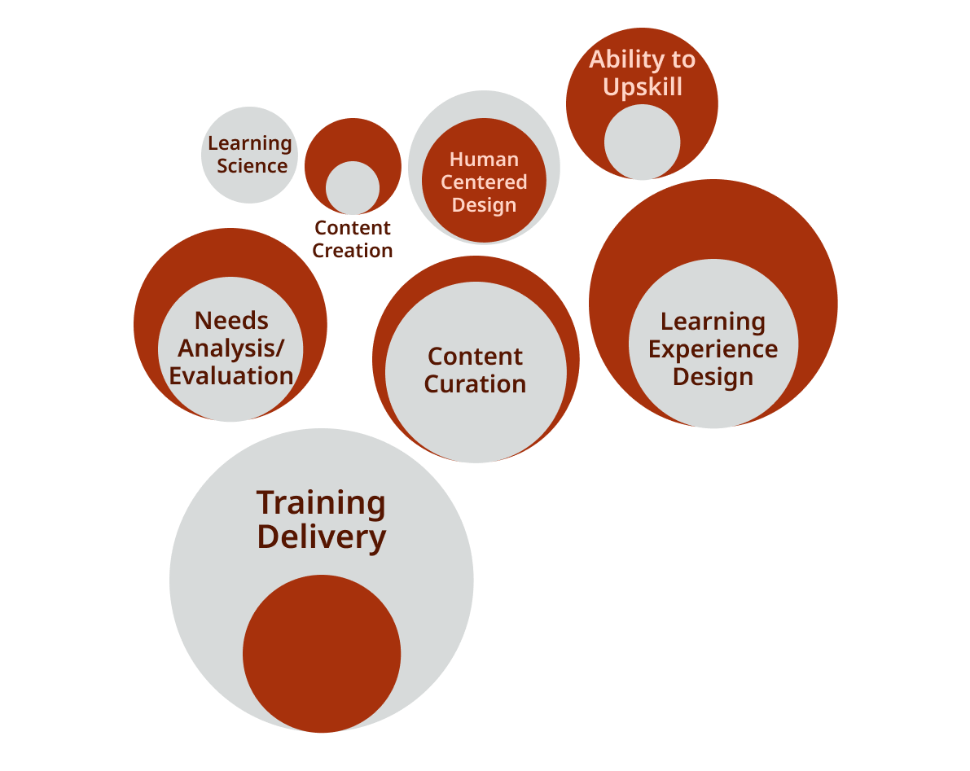
Figure 8: L&D Core skills group – % of focus on each skill, n=105 | RedThread Research, 2022
Training Delivery and Learning Experience Design top the list of essential skills in L&D Core. This is not surprising, given that many L&D pros get degrees and certifications in these skills, and have based their careers on their application.
However, what was surprising was the number of other skills that popped up in this skills group. Human-Centered Design, for example, or the Ability to Upskill, have been recognized only relatively recently as skills that L&D pros need.
Another unsurprising but still growing skill was Content Curation. Its relative prominence hints that L&D pros understand that their responsibilities go much further than creating a course. It may have more to do with assembling the right information and creating the right context and experience.
When we talked to L&D pros about the skills they need specific to L&D, we heard traditional answers, but with a twist. For example, where Training Delivery used to be all about facilitating classroom initiatives, L&D pros mentioned new methods used to “deliver” learning, including coaching, stretch assignments, and external content.
L&D leaders are also looking for broader skill sets when it comes to L&D Core. Ryan Cozens, Learning & Development Lead, Well Health, said:
I think instructional design is an important skill, but it can’t be the only skill. There have to be mindsets and behaviors tied to that. I’m not just looking for someone with the ability to design really incredible self-directed asynchronous learning; I’m looking for someone who understands and can see the bigger picture.
Indeed, L&D Core skills are changing. L&D pros are looking at traditional skills differently, and they're introducing new ones for the future.
L&D Core: Blind Spots
L&D Core skills were the 3rd most important group of skills identified by the L&D pros we surveyed. But, as we saw above, when we look at the focus of L&D pros in high-performing organizations versus those in other organizations, we see they rated L&D Core skills at the same level as Business Core.
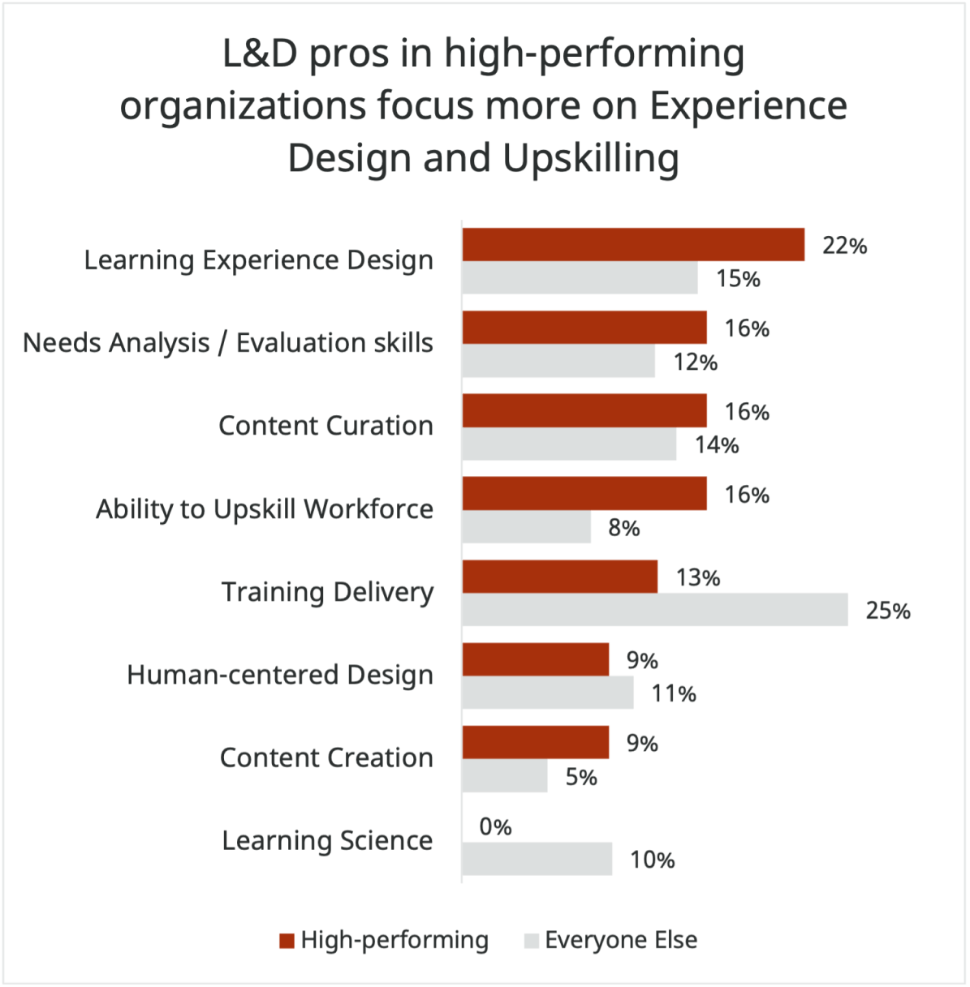
Figure 9: L&D Core skills focus, L&D pros in high-performing orgs vs. L&D pros in other orgs, n=105| RedThread Research, 2022
That Business Core and L&D Core are considered equally important is telling. It indicates that L&D in high-performing organizations are likely more aligned to and focused on business challenges than more traditional L&D functions.
There are also some key differences between the particular focuses of L&D pros from high-performing organizations focus and those in other organizations. Two caught our eye.
Focus more on Experience Design and Upskilling the Workforce
First, L&D pros in high-performing organizations focus more on Learning Experience Design (7 percentage points more) and Upskilling the Workforce (8 percentage points more) than their counterparts in other organizations.
These differences might indicate that L&D pros in high-performing organizations are more attuned to the entire experience of learning and ensuring that the workforce has the right skills. This, in concert with the other skills they find essential, may indicate a more holistic, intentional approach to learning in general.
Focus less on Training Delivery and Learning Science
This brings us to the second big difference. L&D pros in high-performing organizations focused significantly less on Training Delivery (12 percentage points less). While Training Delivery was the most important skill in L&D Core for L&D pros in other organizations, it was 5th out of 8 skills for those in high-performing organizations.
Likewise, while L&D pros mentioned Learning Science as a skill they thought they needed for the future, not one L&D professional in a high-performing organization mentioned it. Does this mean Learning Science is not necessary? Absolutely not. But it does mean that L&D functions that focus too heavily on traditional learning science, without considering the new context (technology, mindsets, motivations, etc.), may not be using their L&D development time or dollars in the best way.
Business Core
Increasingly, L&D pros consider themselves a part of the business rather than an entity that serves the business. This idea came through loud and clear in the research: L&D pros identified skills that are necessary for collaborating with other business functions.
Business Acumen and Marketing top the list for important Business Core skills, according to L&D pros.
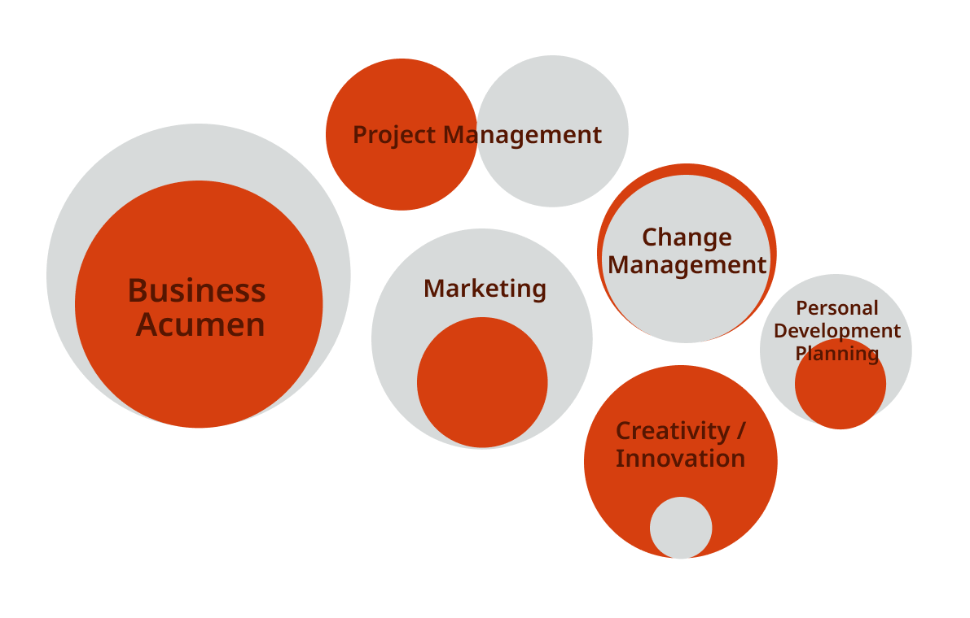
Figure 10: Business Core skills group – % of focus on each skill, n=87 | RedThread Research, 2022
Figure 10: Business Core skills group – % of focus on each skill, n=87 | RedThread Research, 2022
Among the skills mentioned in the research, Business Acumen topped the list. Leaders mentioned 3 aspects of Business Acumen.
Understanding organizational goals and strategy. L&D pros are more proactively evaluating their business direction and determining the best ways to build a skilled workforce than in previous years. Brandon Wolfram, HR Manager for Learning and Performance Solutions at SaskTel, put it this way:
We used to get more operational requests—things like, “Hey, we need some training on this topic,” or “Can you put something together on this.” Now, we get requests like, “Can you partner with us to solve this complex business challenge.
Understanding business basics. L&D functions are professionalizing. Many see themselves not as a traditional cost center but as a contributing member to business growth. As such, project management, change management, and their creativity and innovation muscles are increasingly important.
Speaking the same language. For years, L&D functions have embraced adult learning theory and the research surrounding it. While that is all good, leaders we spoke with understand the need to ditch wonky L&D terms in favor of vocabulary used more broadly.
Focusing on Business Core skills draws them into the business itself, erasing any invisible lines that may have kept them separate. These skills also make it easier to participate in larger strategic discussions.
Business Core: Blind Spots
The blind spots that L&D pros may have around this skills group come down to 2 individual skills.
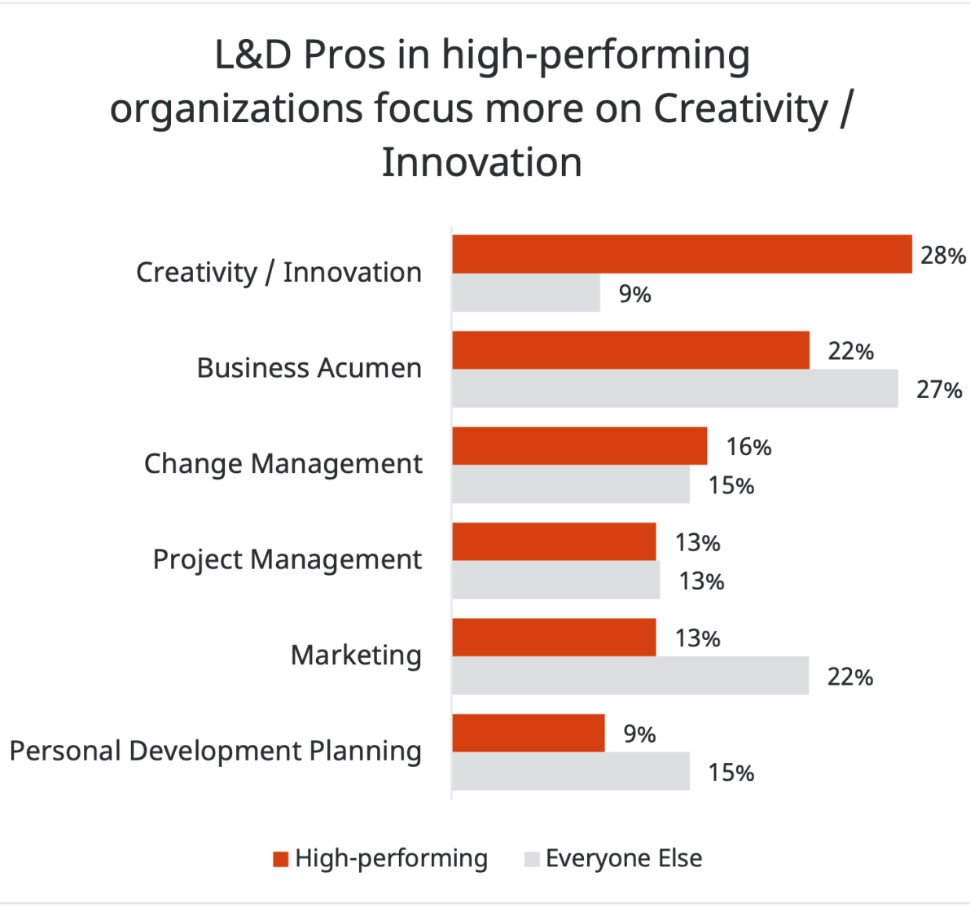
Figure 11: Business Core skills group – Focus of L&D pros in high-performing organizations vs L&D pros in other organizations. n=87 | RedThread Research, 2022
Focus more on Creativity & Innovation
First, L&D pros in high-performing organizations focus significantly more (19 percentage points more) on Creativity and Innovation than their counterparts in other organizations.
The importance of this focus in high-performing organizations aligns with what we heard from learning leaders in our interviews and roundtables. Drew Goodrich, the Director of Learning Enablement at Intuit, spoke about the importance of Creativity & Innovation for his team:
Let's get inspired by anything that’s working and done well and takes hold and gets people to do things. That's a lot more creative than just standing up PowerPoint slides or doing a breakout session—let’s get creative.
L&D pros in high-performing organizations are less likely to worship the status quo. They tend to focus on finding creative solutions to business challenges and taking more risks.
Focus less on Marketing (courses)
L&D professionals in high-performing organizations and their peers in other organizations also focus differently on Marketing.
Marketing, in this case, refers to using marketing techniques to encourage employees to participate in learning interventions. While L&D professionals in general seem to see this as a critical skill, L&D professionals in high-performing organizations were not as interested (9 percentage points less).
While it's beneficial for L&D, focusing too heavily on Marketing may indicate a fairly traditional approach to learning: “If you create an awesome course and market it the right way, they will come.”
That L&D pros in high-performing organizations are focusing so much more on Creativity & Innovation indicates that they may also be broadening their views of learning, including methods that may not be as easily “marketed” in the traditional sense.
This means that L&D pros should likely broaden “marketing” to include strategies that make all learning opportunities “discoverable.”
Managing Relationships
Several skills mentioned by L&D pros had to do with building and managing relationships. We grouped these skills into the larger skills group, Managing Relationships.
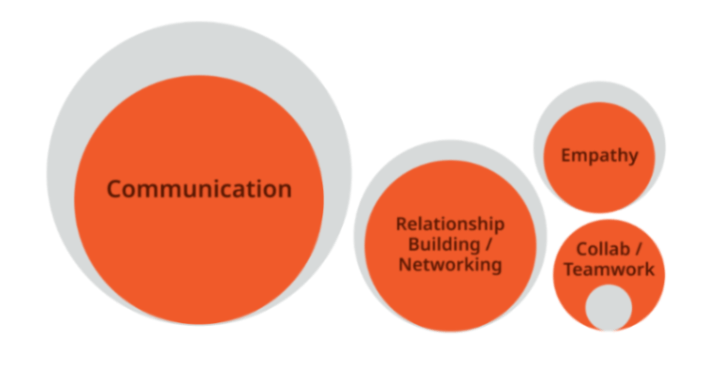
Figure 12: Managing Relationships skills group – % of focus on each skill, n=73 | RedThread Research, 2022
L&D pros who spoke with us in the roundtable and in interviews identified 3 areas where they found managing relationships crucial.
First, L&D pros found it necessary to manage the organization's relationship with L&D. Learning is an entirely voluntary activity—you can force someone to complete an e-learning course, but you can’t force them to learn the content.
L&D pros spoke of developing trust with the organization —communicating the benefits of consistent development and empathizing with employees when creating and delivering initiatives. One leader emphasized the importance of listening as a part of communication:
I think the hardest part is hearing. Not just hearing enough to fall in love with the problem, but hearing enough to solve the problem. And then creating.
Second, L&D pros increasingly see their networks and relationships with others in the organization as the key to their success. Some mentioned these relationships in the context of understanding key aspects of the business in order to meet their development needs. Others mentioned these relationships as crucial to getting things done. Relationships were crucial for tasks from understanding who to speak to in procurement to identifying the strongest SME for a specific project. Another leader said:
I’m a big believer in networking: getting to know lots of different people, and not getting too deeply dug into one particular discipline. Because if you do, you forget how all of these things are connected.
Finally, L&D pros also mentioned the need for Relationship-building and Networking as key to increasing their own knowledge and understanding. They also mentioned the need to identify the best ways to build those skills in the employee population at large.
Managing Relationships: Blind Spots
Consistent with our finding about Networking, we found that L&D pros across organizations place value on skills around Managing Relationships.
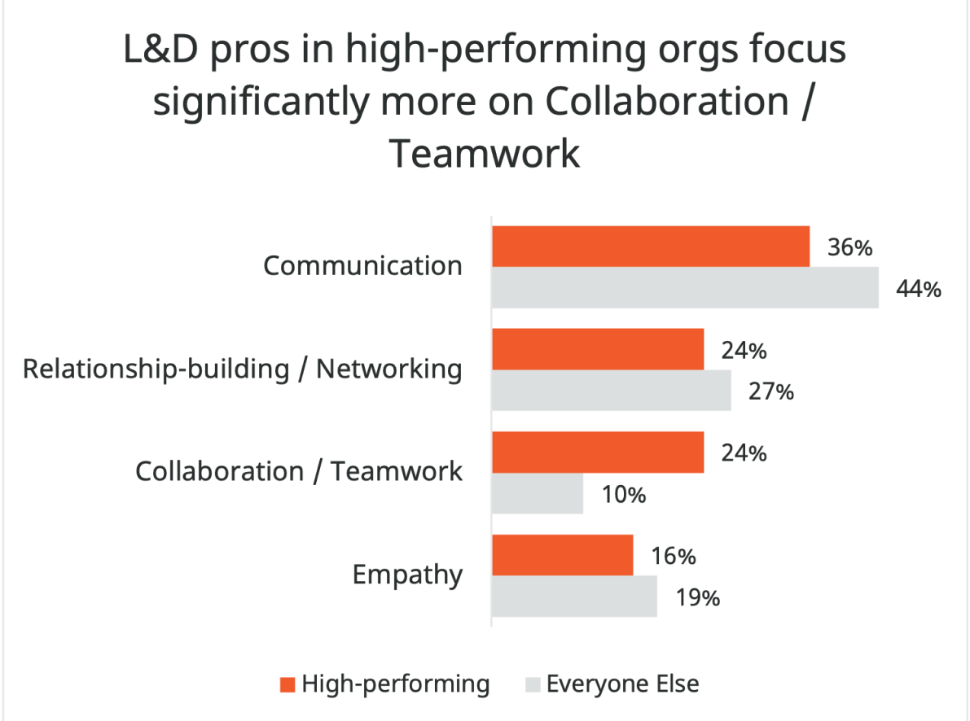
Figure 13: Managing Relationship skills focus – L&D pros in high-performing orgs vs. L&D pros in other orgs, n=73 | RedThread Research, 2022
Focus more on Collaboration & Teamwork
When we look at the focus on specific skills, however, there is a different story. Collaboration & Teamwork received significantly more attention (14 percentage points more) by L&D pros in high-performing organizations.
This focus indicates that L&D pros in these organizations realize that learning cannot just be the responsibility of the L&D function. It has to involve everyone in the organization. Drew Goodrich at Intuit says they leverage collaboration to help with strategy:
It's good there’s a lot of teamwork and collaboration and co-creation and co-planning. Getting everyone involved and getting everybody’s hands on it means you’ll actually stick to your strategy.
In essence, part of L&D's job is to deputize the organization – get everyone on the same page and build cross-functional systems that support a learning culture. That can only be done through carefully managing relationships.
Readiness
When asked, 10% of L&D pros identified Readiness skills as necessary for the future. Readiness skills are those universal skills that allow L&D functions to do their jobs in ever-changing, often chaotic circumstances. L&D pros recognized 4 skills within that category.

Figure 14: Readiness skills group – % of focus on each skill, n=67; note: n=24 for L&D pros in high-performing organizations | RedThread Research, 2022
The past couple of years have required significant change for most organizations. That need has also trickled down to L&D functions. They have had to adapt many traditional training methods to serve hybrid and remote employees. They are also being tasked with leading initiatives such as DEIB or Return to Office (likely more than once).
These changes are forcing L&D pros to be more adaptable, agile, resilient, and efficient.
The Readiness skill group the majority of them spoke of them as capabilities needed by the L&D function, not necessarily the individual. Many talked about changing mindsets, systems, and processes to make the function itself more adaptable and agile.
For example, L&D leaders mentioned they were doing things like:
- Moving away from traditional waterfall development processes and toward agile approaches, because waterfall slowed them down too much
- Recognizing the perishable nature of learning and encouraging L&D pros not to fall in love with any one solution. Thinking instead of the lifecycle of the solution and put into place evaluation triggers and plans for sunsetting or replacing them
- Adapting to immediate needs versus making sure that something is 100% perfect before launching
- Experimenting and taking risks, gathering data, and adjusting as they go instead of only measuring at the end
One leader summed up all of these ideas as she described how her L&D function was becoming more nimble:
We need to be OK with putting something out there that isn’t 100% polished, because we need to move fast. Then we see what happens. Then we need to gather feedback and adjust.
The funny thing is, we’ve been paying lip service to these skills for years. But recently, probably prompted by external events, L&D pros are doing more than just talking about them.
Readiness: Blind Spots
L&D pros from all organizations put the greatest focus on Agility in this category. They also agree that Adaptability & Flexibility are important skills. But then we see some differences.
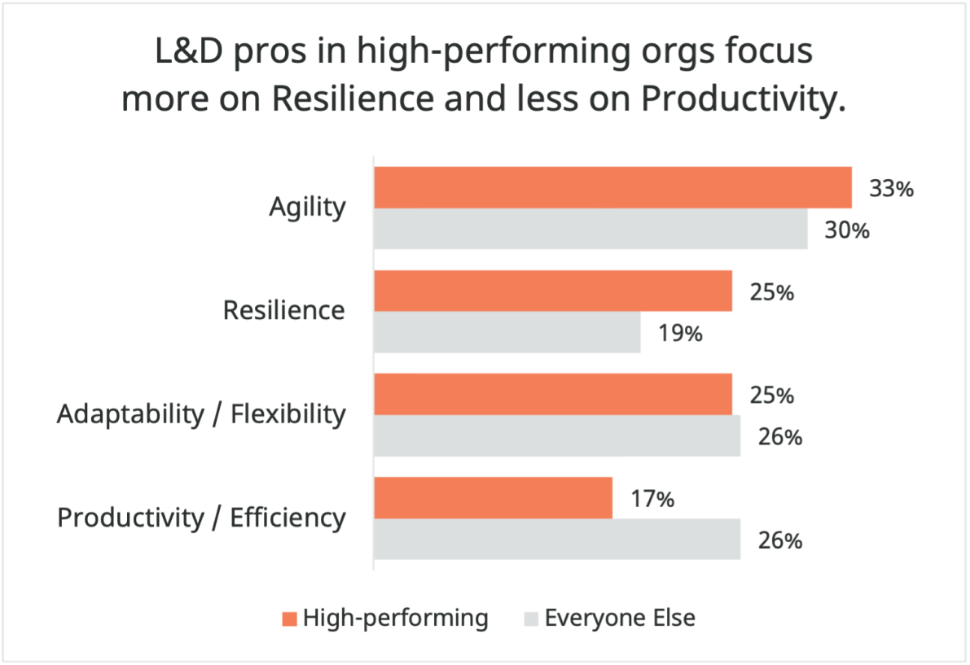
Figure 15: Readiness skills focus, L&D pros in high-performing orgs vs. L&D pros in other orgs, n=67; note: n=24 for L&D pros in high-performing organizations | RedThread Research, 2022
Focus more on Resilience
L&D pros in high-performing organizations focus on Resilience more than their peers in other organizations (7 percentage points more). The 2011 journal article “What Is Resilience?” describes Resilience as positive adaption, or the ability to maintain or regain mental health.
From our interviews and roundtable discussions, we learned that L&D leaders are looking at Resilience in 2 ways.
First, L&D leaders recognize the changes their own functions have encountered recently and understand that Resilience is key to quick adaptation.
Second, L&D pro are considering how Resilience can be taught, encouraged, and systematized within their organization so that their workforce can handle future changes and disruptions.
Focus less on Efficiency & Productivity
Interestingly, L&D pros in high-performing organizations tend to focus significantly less on Efficiency and Productivity (9 percentage points less). We’re fans of efficiency, and we think all L&D functions should strive to be more efficient and productive. But we also know that change is often messy, requiring inefficiencies and experimentation to find new and better ways of doing things.
The combination of these 2 things—greater focus on resilience and less on efficiency—likely lead to more experimental and risk-friendly environments.
L&D functions may want to consider how much respective focus they put on Resilience and learning from mistakes versus institutionalization and standardization.
Tech
Finally, Tech. Nine percent of L&D pros mentioned Tech skills when determining which skills will be needed for the Tech plays a pretty important role in the work of L&D pros, and that role appears to have been magnified as organizations were forced to adopt remote and hybrid work models.
Even before the pandemic, however, L&D pros saw tech as a way to engage, scale, personalize, evaluate, and quantify learning. Organizations had also started to move toward a digital mindset. As organizations have begun to adopt skills a skills mindset, tech has only become more critical.
L&D pros identified tech skills in basically 2 flavors, as shown in Figure 16.
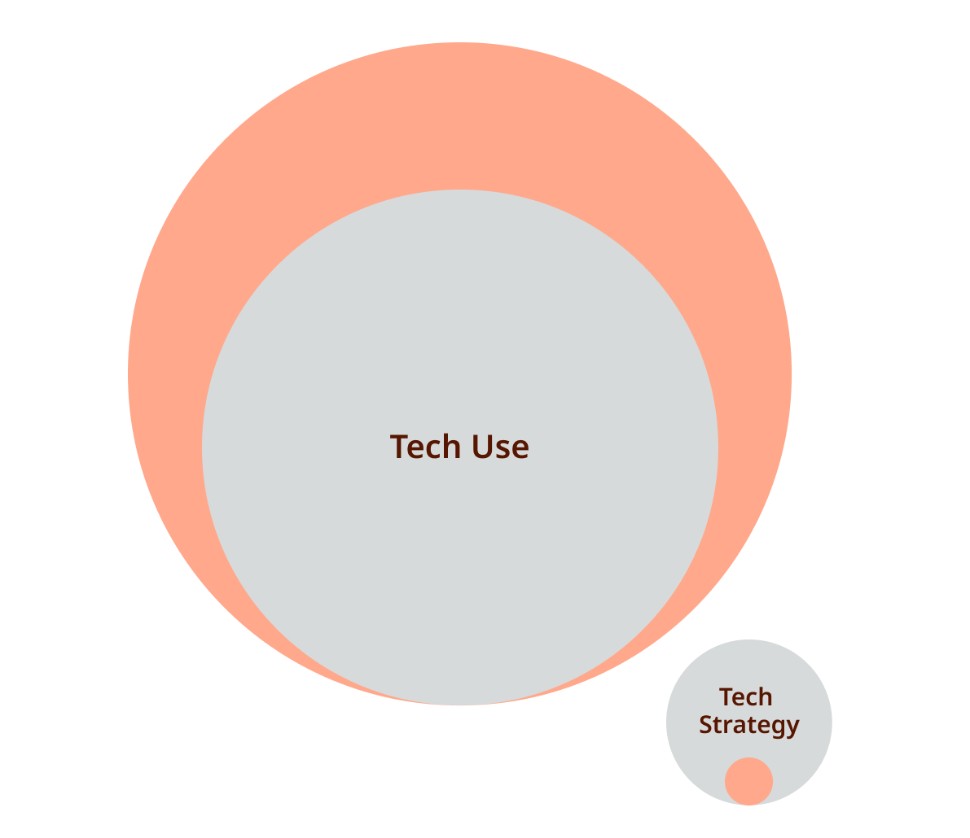
Figure 16: Tech skills group – % of focus on each skill, n=60; note: n=14 for L&D pros in high-performing organizations | RedThread Research, 2022
L&D pros overwhelmingly identified skills related to using tech more effectively in their roles. In fact, Tech Use was the second most mentioned skill overall—second only to Data Analysis. However, we want to note some nuances in the interviews that we feel are important.
First, L&D pros mentioned that as their organizations have fully embraced hybrid and remote work, many employees lack the skills necessary to work in these environments effectively. Karen Dowdall-Sanford, Senior Director of L&D at Flyhomes put it like this:
Once again, there’s a skill set specific to virtual collaboration and how you use Teams or Slack effectively. There’s the technical skill set of just understanding the tool, but then there are also norms and practices and behaviors that run into how to do it effectively.
L&D pros appear to understand that they need skills to help others develop skills in virtual collaboration—something we think we’ll see more of.
Second, some L&D pros mentioned 2 skill sets that fall under tech use. First, a skill set needed to use the tech effectively. Second, a skill set associated with creating the right environment around that tech. Tech that doesn’t integrate with the organization doesn’t work. Mitchel McNair, Global Learning & Career Consultant at Dow, said it like this:
We’re doing some things in technology, but the huge technology piece is probably the easiest piece. The bigger challenge is the culture and processes and L&D work design.
The other piece of the Tech skills group is Tech Strategy. Tech Strategy focuses less on the skills needed to use individual technologies and more on how the technologies work together to create the experience.
Tech Strategy often involves tech outside of the L&D function, such as tech that is leveraged from other business functions. (Teams and Slack are good examples).
A strong tech strategy also identifies places of intersection with other business tech and ensures that the learning tech roadmap aligns with the vision of the larger organization.
Tech: Blind Spots
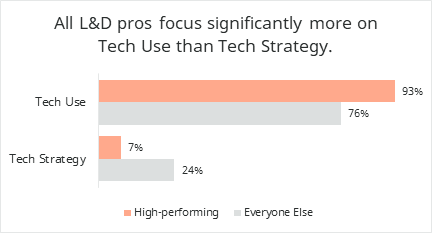
Figure 17: Tech skills focus, L&D pros in high-performing orgs vs. L&D pros in other orgs, n=60 note: n=14 for L&D pros in high-performing organizations | RedThread Research, 2022
Focus more on Tech Strategy
None of our research indicated much difference between the focus of L&D pros in high-performing organizations versus those in other organizations. All L&D pros focused heavily on Tech Use.
Frankly, we wish we had an explanation for this, as we expected to find the opposite. However, it looks like high-performing organizations are still, as are most talented L&D pros, thinking about what the tech can do and less about how it fits together.
Therefore, the blind spot associated with technology is common to all L&D pros, regardless of their organization’s performance. All L&D pros should focus more time and effort on creating the experience, including determining how technology pieces fit together, the overall technology strategy, and how it aligns with the organization’s tech strategy.
Wrap Up: Upskill, L&D
Undoubtedly, organizations are focusing on upskilling their workforces. And, undoubtedly, L&D pros have a big role to play in that effort. Exciting times are ahead, but L&D pros need to be prepared.
To use a well-known metaphor, L&D pros are sitting in an airplane experiencing some turbulence. The oxygen masks have dropped, and L&D needs to take the time to put theirs on first before ensuring that employees get theirs on as well.
So upskill, L&D. We learned a lot in this study about where L&D pros should focus their efforts. Knowing is half the battle. The other half – making the time and actually doing the development – is the harder part, but we think crucial to the continued efficacy of L&D functions everywhere.
Note: for Appendices, including skills definitions, study demographics, research methodology, and contributors please download the PDF report.